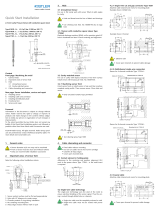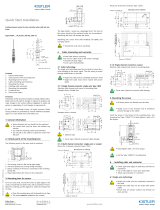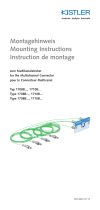
Praxistipps für die Hand-
habung der Single-Wire-Kabel
Montage:
1. Stecker aufdrehen
Den Stecker entgegen des
Uhrzeigersinns, soweit auf-
drehen, bis das Kabel einge-
führt werden kann.
2. Kabel abschneiden
Das Kabel auf die benötigte
Länge kürzen. Ausreichende
Kabellänge für die Stecker-
montage berücksichtigen.
Das Kabelende darf nicht
abisoliert werden.
3. Kabel montieren
Das Kabel bis zum Anschlag
einschieben.
4. Stecker zudrehen
Den Steckergriff im Uhr-
zeigersinn fest zudrehen.
Das Kabel wird hierbei auto-
matisch abisoliert und ver-
klemmt.
5. Befestigungskontrolle
Am Kabel mit der Hand
leicht ziehen. Kabel darf sich
im Stecker nicht bewegen.
6. Steckereinbau
Die Montageplatte mit befe-
stigtem Schutzdeckel und
Stecker in der Werkzeugver-
tiefung montieren.
2
3
4
1
Reparatur:
Beschädigte oder abgescherte Single-Wire-Kabel
können auf einfache Art und Weise repariert werden.
1. Kabel defekt
2. Kabelenden abisolieren
3. Kabelenden verzinnen,
Fluorpolymer- und
Schrumpfschlauch an-
bringen
4. Kabelenden zusammen-
löten
5. Lötstelle mit Fluorpoly-
merschlauch isolieren
6. Reparaturstelle zur
Fixierung mit Schrumpf-
schlauch umhüllen
2
3
4
5
6
1
Practical Tips for Handling
Single-Wire Cable
Installation:
1. Unscrewing the connector
Unscrew the connector
anticlockwise far enough
to allow the cable to be
inserted.
2. Cutting the cable to length
Shorten the cable to the
length required. Ensure ade-
quate cable length for fitting
the connector. The end of
the cable must not be strip-
ped of insulation.
3. Fitting the cable
Insert the cable as far as it
will go.
4. Screwing in the connector
Screw in the connector firm-
ly clockwise. The connector
thereby automatically strips
the cable of insulation and
grips it.
5. Checking the connection
Pull on the cable lightly by
hand. The cable must not
move out of the connector.
6. Installing the connector
Install the mounting plate
(with protective cover fitted)
and the connector in the
mold groove.
6a
6b
2
3
4
1
6a
6b

Kistler Gruppe
Eulachstrasse 22
8408 Winterthur, Schweiz
Tel. +41 52 224 11 11
Fax +41 52 224 14 14
info@kistler.com www.kistler.com
002-687m-10.15 ©2015, Kistler Group
Repairs:
Damaged or sheared-off single-wire cable is quite
easy to repair.
1. Broken cable
2. Strip the insulation from
the cable ends
3. Tin the cable ends and
push on Fluoropolymer
and shrink-fit hose
4. Solder the cable ends
together
5. Insulate the soldered
position with
Fluorpolymer hose
6. Cover the repair with
shrink-fit hose
Conseils pratiques pour
la manipulation du câble
monoconducteur
Installation:
1. Dévisser le connecteur
Dévissez le connecteur
jusqu’à ce qu’il soit possible
d’insérer le câble.
2. Couper le câble à la
longueur désirée
Raccourcissez le câble à la
longueur requise. Assurez-
vous que la longueur soit
suffisante. Veillez à ne pas
dénuder l’extrêmité du
câble.
3. Installer le câble
Insérez le câble jusqu’à ce
qu’il ne puisse aller plus loin.
4. Revisser le connecteur
Revissez le connecteur. Le
câble est ainsi automatique-
ment dénudé et mis en
place.
5. Contrôler la connexion
Tirez légèrement sur le
câble. Celui-ci ne doit pas
pouvoir bouger à l’intérieur
du connecteur.
6. Installer le connecteur
Installer la plaque de mon-
tage (avec le couvercle de
protection) et le connecteur
dans l’espace prévu à cet
effet.
Réparations:
Les câbles abîmés sont faciles à réparer.
1. Câble coupé
2. Dénudez les extrêmités
du câble
3. Roulez les extrêmités du
câble et ajustez les
Fluoro-polymère- et gai-
nes thermo-rétractables
4. Soudez les deux extrê-
mités du câble
5. Isolez la partie soudée
à l’aide de la gaine
Fluoropolymère thermo-
rétractable
6. Recouvrez la partie
réparée avec l’autre gaine
thermo-rétractable
2
3
4
5
6
1
2
3
4
1
6a
6b
2
3
4
5
6
1
-
 1
1
-
 2
2
in anderen Sprachen
- English: Kistler 1207 Quick start guide
- français: Kistler 1207 Guide de démarrage rapide






